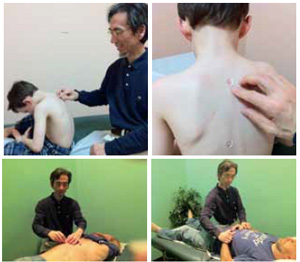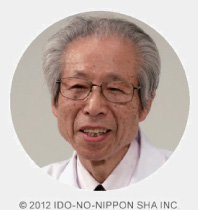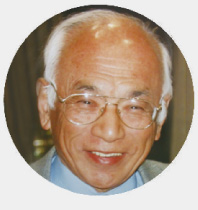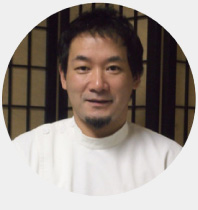TESTIMONIAL
HOME > TESTIMONIAL > Kuwahara, T. Koei

Kuwahara, T. Koei
L.Ac.
President of the Hari Society and the Ki Science Institute
Assistant Professor at the New England School of Acupuncture
Introduction to New Pyonex
One of my favorite acupuncture techniques that I have used consistently in over 30 years of practice is the press tack. It’s an important clinical tool for increasing, consolidating, and extending the effect of treatment. The use of press tacks is becoming even more popular today. It is used not only for pain management, which acupuncture is already known for, but more broadly for pediatric treatments, internal diseases, and psychosomatic conditions, as well as health maintenance. This is because a new breed of press tacks called New Pyonex has extended its application into many conditions. I would like to introduce some of the advantages of New Pyonex and some of the ways in which I apply New Pyonex and I hope this will encourage more practitioners to use them.
Their Safety and Utility as a Treatment Tool
- They are extremely easy to place on the point. No special practice is needed, and anyone can attach them securely on the intended acupuncture point.
- Even slight pain is rare when placing these press tacks, so even little children do not realize they are getting acupuncture.
- The micropore tape, the needle, and the plastic head of the needle are seamlessly connected so that the press tack is firmly attached to the skin. So the needle doesn’t lift off the skin and cause discomfort even when there is movement. Also it rarely comes off by itself, so the patient doesn’t lose the press tack.
- The miniscule needle is embedded in the adhesive tape and is enclosed in sterile packaging so that it cannot be contaminated in the clinic and the needle is never lost due to mishandling in the clinic.
- One big advantage is that there are five different lengths of which 0.3mm is the shortest. The thickness of most patients’ skin is over 1mm, so the needle tip remains securely within the skin.
The ways I apply New Pyonex
(A) Cases of pain
- Acute cases:
- Apply on same point of same channel on opposite side of painful point.
- Apply on Jing Well, or Ying Spring point of channel that goes through painful area.
- Sub-acute and chronic cases:
- Apply on Yuan Source, Xi Cleft, or Luo Connecting point of same channel on opposite side of pain.
- Apply on boundary of normal and affected area on the channel either upstream or downstream. Also one can apply on either of these points based on palpating stronger Ki stagnation (tenderness, hardness, coldness, rough skin, etc.).
- Apply on a point at the origin and insertion of the muscle in pain.
- Chronic pain: In addition to
- above,
- Apply to Yuan Source, Xi Cleft, or Luo Connecting point etc. on the opposite side on the channel that is the Yin-Yang opposite in the same category (six stages). For example in the case of left baseball elbow (pain on Small Intestine channel), KI-7 or KI-8 on the right can be effective.
- Apply on most tender point in the affected area.
(B) Cases of pain from internal diseases
- Differentiate the cause and location of the disease based on channel theory. Then apply on the tender Xi Cleft or Luo Connecting point etc. on the healthy side of channel that is in midnight-midday relationship to the affected channel.
- Apply on the Confluent Point pairs of related Extraordinary Vessels.
- Also apply as explained under 3) for Chronic Pain above.
(C) Other applications
- Apply on Back Shu points based on the diagnosis. Apply on these points by palpating tenderness or depression.
- Apply on points showing clear difference by palpation method mentioned below. Apply on points that are still tender or tight after treatment.
- Apply on points that are known for special effects. For example, GV-12 is effective for colic or hysteric crying in little children (Kanno- mushi).
Do not apply New Pyonex on too many points using the above methods. First find and mark reactive points by palpation (press or pinching), give a patient your core system of treatment (like as root treatment in Meridian therapy) and then carefully repalpate these points to reduce the number of points. At that time, change your palpation method. Instead of pressing to reach below the skin, palpate very gently by stroking over the skin. In this way you find points where the skin is slightly thicker, or rough, or where it seems stuck to layers underneath. Apply New Pyonex directly over these findings. I call these “Live Volcano Points.” When you learn to use not only tender points, but these “Live Volcano Points,” you can get a 100% effect. And the effect starts immediately after appling New Pyonex. The relief and pain will alternate every 2 to 3 hours like the tide, but there will be a clear and sustained effect for one or two days. Another way to maintain the effect is to have the patient gently tap or flick the plastic button on the New Pyonex with a fingertip. The effect rapidly diminishes two to three days after placement, so you must relocate the point and apply another one. Effective points move. This is my approach to New Pyonex application.
 One last thing. Application of New Pyonex on active points along with home moxibustion (using stickon moxa) on indicated Confluent Point pairs of the Extraordinary Vessels is an excellent way to reduce the treatment period by maintaining the effect of treatment. It speeds up the healing process and this increases the return rate of patients, so it’s good for business. Currently New Pyonex is a bit more expensive than other press tacks but its benefits far out weight its costs. It is a product that satisfies both the practitioner and patient’s needs, so I highly recommend New Pyonex.
One last thing. Application of New Pyonex on active points along with home moxibustion (using stickon moxa) on indicated Confluent Point pairs of the Extraordinary Vessels is an excellent way to reduce the treatment period by maintaining the effect of treatment. It speeds up the healing process and this increases the return rate of patients, so it’s good for business. Currently New Pyonex is a bit more expensive than other press tacks but its benefits far out weight its costs. It is a product that satisfies both the practitioner and patient’s needs, so I highly recommend New Pyonex.

















